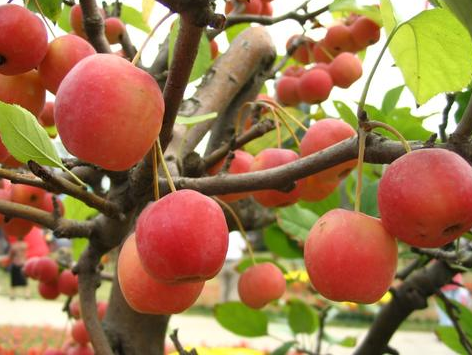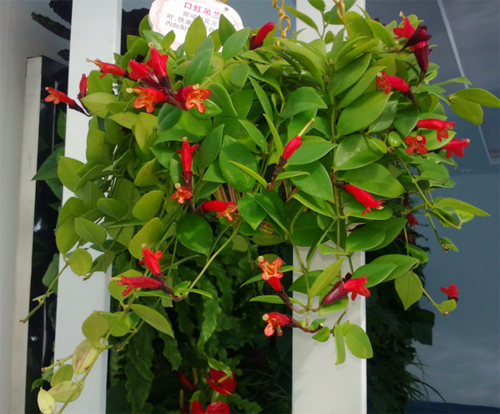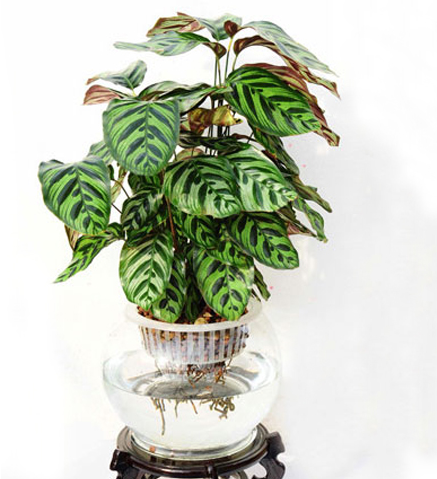Winter red fruit potted cultivation method can eat it
Winter red fruit can now be potted culture, but many people find that potted culture winter red fruit is always not good, how can this be done? What is the potted cultivation method of winter red fruit? Can I eat red fruits in winter?

Winter red fruit potted cultivation methods:
Donghongguo likes sunny and cool dry environment, cold resistance, fear of damp heat, suitable for rich humus, loose fertile, good drainage sandy soil growth.
Generally transplanted in the spring of each year or on the pot, the growth period requires sufficient sunlight, if the light is insufficient, it will affect the color of the fruit, plant shape and results, so the ground can be planted in the courtyard sunny ventilation, potted plants should be placed in a sunny place.
1. Watering
Winter red fruit growth period to keep the soil moist and not water, June of each year for flower bud differentiation period, should control watering 2 weeks to 3 weeks, such as young leaves wilted when watering, in order to promote the formation of flower buds.
2. Fertilization
Nitrogen fertilizer can be appropriately increased in the early stage of plant growth, and nitrogen fertilizer can be controlled or stopped after June. The application amount of phosphorus, potassium, calcium, magnesium and other trace elements can be increased to improve fruit quality and ornamental effect, and to make branches develop fully, which is beneficial to flower bud formation.
3, pruning
And remove the tender tip of the top of the branch in time to prevent the extension of the branch, so that it redistributes nutrients, which is conducive to the development of the fruit.
4. Sunlight and plastic surgery
Winter red fruit is not resistant to high temperature, summer if a long time higher than 35 ℃, can be properly shaded ventilation, cooling. Potted plants in winter can be buried in the pot outdoor shelter sunny place or placed in 0℃ to 10℃ cold indoor winter. Before germination in spring, the plants were trimmed once, cutting off diseased dead branches, cross branches, over-dense branches and excessive branches, and cutting off too long branches for ventilation and light transmission, and maintaining the elegance of the tree shape.
5. Pot change and soil selection
Winter red fruit generally every 1 to 2 years before the spring germination of the pot once, pot soil can be decayed leaf soil, garden soil 1, coarse sand 0.5, and add a small amount of hoof or decomposed animal dung as base fertilizer.
Can I eat red fruits in winter?
Winter red fruit is an ornamental plant, fruit can be eaten, will not be poisoned, but this fruit is not suitable for everyone's physique to eat, so can not eat.
Winter red fruit introduction:
Donghongguo is a deciduous shrub or small tree of Rosaceae and Apple. The plant is short, the branches are gray brown, the leaves are elliptic to wide elliptic, green, and the edges are round and blunt.
Corymbs, pale pink flowers, spring open.
Fruit ellipsoid, fruit is relatively small, green at first, gradually mature yellow, mature red, smooth skin, do not fall through winter, can last until February to March of the second year before falling off.
The introduction of winter red fruit is here, hurry to raise a plant, grow like a small apple.
How to maintain winter red fruit potted plant
Winter red fruit for Rosaceae, apple deciduous shrubs or small trees, let's take a look at the winter red fruit potted conservation methods.
Winter red fruit plant short, branches grayish brown, fruit ellipsoid, single fruit weight 10 grams to 20 grams, green at the beginning, gradually yellow later, mature red, smooth epidermis, after winter does not fall, can last until February to March of the second year before falling off one after another. The propagation of winter red fruit can be used as rootstock of begonia, negundo or apple seedlings, with healthy branches or plump buds slightly above the middle as scion, grafted by means of cleavage, cutting and budding.
The propagation of winter red fruit can be used as rootstock of begonia, negundo or apple seedlings, with healthy branches or plump buds slightly above the middle as scion, grafted by means of cleavage, cutting and budding.
Winter red fruit is a variety of apple, its tree shape is compact, spring pale pink flowers full of branches, autumn and winter trees full of exquisite lovely fruit, its fruit shape resembles apple, suitable for garden planting or potted plant viewing, making bonsai.
Donghongguo likes sunny and cool dry environment, cold resistance, fear of damp heat, suitable for rich humus, loose fertile, good drainage sandy soil growth. Generally transplanted in the spring of each year or on the pot, the growth period requires sufficient sunlight, if the light is insufficient, it will affect the color of the fruit, plant shape and results, so the ground can be planted in the courtyard sunny ventilation, potted plants should be placed in a sunny place.
Winter red fruit growth period to keep the soil moist and not water, June of each year for flower bud differentiation period, should control watering 2 weeks to 3 weeks, such as young leaves wilted when watering, in order to promote the formation of flower buds. Nitrogen fertilizer can be appropriately increased in the early stage of plant growth, and nitrogen fertilizer can be controlled or stopped after June. The application amount of phosphorus, potassium, calcium, magnesium and other trace elements can be increased to improve fruit quality and ornamental effect, and to make branches develop fully, which is beneficial to flower bud formation. And remove the tender tip of the top of the branch in time to prevent the extension of the branch, so that it redistributes nutrients, which is conducive to the development of the fruit.
Winter red fruit is not resistant to high temperature, summer if a long time higher than 35℃, can be properly shaded ventilation, cooling. Potted plants in winter can be buried in the pot outdoor shelter sunny place or placed in 0℃ to 10℃ cold indoor winter. Before germination in spring, the plants were trimmed once, cutting off diseased dead branches, cross branches, over-dense branches and excessive branches, and cutting off too long branches for ventilation and light transmission, and maintaining the elegance of the tree shape.
Winter red fruit for Rosaceae, flowers 5-12 clusters, flowers pale pink, spring open, smooth epidermis, after winter does not fall.
If you still want to know more about it, you can continue to pay attention to No.1 Home Network.
Winter red fruit bonsai, winter red fruit can eat it, winter red fruit pictures, winter red fruit prices, winter red fruit varieties winter red fruit apple (Malus) Rosaceae apple subfamily 1 genus. Deciduous sparse semievergreen trees or shrubs, winter buds with imbricate scales. Leaf blade edge serrated or split, in the bud for the folding or sweeping shape, there are stipules. Inflorescences umbellate, petals white to pink. Stamens 15 - 50, with yellow anthers; ovary inferior, 2 - 5-loculed; styles 2 - 5, often connate at base. The fruit is a pome with few or no stone cells. There are about 35 species in the world, mainly distributed in the north temperate zone, including Asia, Europe and North America. There are 23 species in China, widely distributed, but mainly distributed in Shaanxi, Gansu and Sichuan provinces.
Winter red fruit bonsai can be placed in sunny, well-ventilated place maintenance, growth period requires sufficient sunlight, if insufficient light, will affect the color of the fruit, plant shape and results. Keep the soil moist and do not accumulate water. June of each year is the flower bud differentiation period. Water should be controlled for 2 to 3 weeks. When the young leaves wither, water again to promote the formation of flower buds. Nitrogen fertilizer can be appropriately increased in the early stage of plant growth, and nitrogen fertilizer can be controlled or stopped after June. The application amount of phosphorus, potassium, calcium, magnesium and other trace elements can be increased to improve fruit quality and ornamental effect, and to make branches develop fully, which is beneficial to flower bud formation. Remove the tender tip of the top of the branch in time to prevent the extension of the branch, so that it redistributes nutrients, which is conducive to the development of the fruit.
Can I eat red berries in winter?
Winter red fruit is used for ornamental fruit, not edible fruit.
Winter Red Price
Not very expensive, almost a dozen or so yuan, or relatively cheap, and winter red fruit is a variety of apples, its tree shape is compact, spring pale pink flowers full of branches, autumn and winter trees full of exquisite lovely fruit, its fruit shape resembles apples, suitable for garden planting or potted plant viewing, making bonsai.
winter red fruit variety
It is a variety of apple, its tree shape is compact, spring pale pink flowers full of branches, autumn and winter trees full of exquisite lovely fruit, its fruit shape resembles apple, suitable for garden planting or potted plant viewing, making bonsai. Winter red fruit is a variety of apples! Winter red fruit for Rosaceae, flowers 5-12 clusters, flowers pale pink, spring open, smooth epidermis, after winter does not fall.
Winter red fruit cultivation
Donghongguo likes sunny and cool dry environment, cold resistance, fear of damp heat, suitable for rich humus, loose fertile, good drainage sandy soil growth. Usually in the spring of each year on the pot. The growth period requires sufficient sunlight. If the light is insufficient, it will affect the plant shape, fruit color and fruit condition.
Keep the soil moist during the growing season without standing water. June of each year is the flower bud differentiation period, watering should be controlled for 2 weeks to 3 weeks to promote the formation of flower buds. Nitrogen fertilizer can be appropriately increased in the early stage of plant growth, and nitrogen fertilizer can be controlled or stopped after June. The application amount of phosphorus, potassium, calcium, magnesium and other trace elements can be increased to improve fruit quality and ornamental effect, and to make branches develop fully, which is beneficial to flower bud formation. Timely removal of tender tips at the top of branches is conducive to fruit development.
Related encyclopedias
Pocket scale non-woven bag lamp grass bamboo shoots crab feet red rice note3ykk zipper ybs zipper mountain cherry climbing wall plum wild cassia winter plum pine watch Omega Longines famous watch children's building blocks flint azalea orchid roll stick thorn fruit Annona
- Prev

Culture methods and matters needing attention of lipstick hanging orchid when to blossom and its price
There are also many kinds of hanging orchids, there is a kind of lipstick hanging orchid, it is very good-looking, flowering flowers are like people's cherry mouth, lipstick hanging orchid breeding methods and points for attention? When will it blossom? What is the price?
- Next

Is the method of hydroponic culture of peacock bamboo taro poisonous? is it flowering?
Peacock taro is good-looking, good-looking is self-willed, everyone likes, peacock bamboo taro can not only be cultivated in soil, but also can be hydroponic, what is the method of hydroponic culture? Will peacocks blossom? Is it poisonous? The method of water culture of peacock bamboo taro: generally, perlite and vermiculite are used at 1:1, and a little ceramsite is the best.
Related
- Fuxing push coffee new agricultural production and marketing class: lack of small-scale processing plants
- Jujube rice field leisure farm deep ploughing Yilan for five years to create a space for organic food and play
- Nongyu Farm-A trial of organic papaya for brave women with advanced technology
- Four points for attention in the prevention and control of diseases and insect pests of edible fungi
- How to add nutrient solution to Edible Fungi
- Is there any good way to control edible fungus mites?
- Open Inoculation Technology of Edible Fungi
- Is there any clever way to use fertilizer for edible fungus in winter?
- What agents are used to kill the pathogens of edible fungi in the mushroom shed?
- Rapid drying of Edible Fungi

